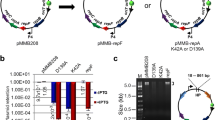Abstract
The tet genes of transposon Tn10 have been mapped in a 2,200 bp DNA sequence by analysing deletion and Tn5 insertion mutations. When the tet genes were present on multi-copy plasmids the level of resistance expressed was about ten-fold lower than that determined by a single copy of Tn10 in the E. coli chromosome. The 36K tet protein known to be encoded by R100 in E. coli minicells was not detected when they harboured a multicopy tet plasmid. However, normal high levels of resistance were expressed when the tet genes were recombined into the host chromosome as part of a lambda lysogen, showing that the multicopy effect was phenotypic. Most of the Tn5 insertions and deletions in tet which caused Tcs mutations also prevented expression of high level Tcr from a chromosomal Tn10 element present in the same cell. Only those insertions in the promoter-proximal 90–130 bp of a 1,275 bp HindII fragment known to carry the gene encoding the 36K tet protein did not reduce the single copy Tn10 resistance level.
A gene fusion system that results in the constitutive synthesis of β-galactosidase from a tet promoter has been used to assay tet repressor activity. The basal (uninduced) β-galactosidase level in cells carrying multicopy tet plasmids was 10–20 fold lower than those carrying a single copy. The tet:: Tn5 mutants defective in the trans-dominant multicopy effect still made normal amounts of tet repressor showing that repressor overproduction was not responsible for this effect. In addition a repressor-defective constitutive mutant did not exhibit a higher resistance level when located on a multicopy plasmid vector. We postulate that a regulatory mechanism recognises the amino-terminus of the tet structural gene product when attempts are being made to overproduce the protein and prevents further translation.
Similar content being viewed by others
References
Ball PR, Shales SW, Chopra I (1980) Plasmid-mediated tetracycline resistance in Escherichia coli involves increased efflux of the antibiotic. Biochem Biophys Res Commun 93: 74–81
Beck CF (1979) A genetic approach to analysis of transposons. Proc Natl Acad Sci USA 76: 2376–2380
Bochner BR, Huang H-C, Schieven GL, Ames BN (1980) Positive selection for loss of tetracycline resistance. J Bacteriol 143: 926–933
Bolivar P, Rodriguez RL, Greene PJ, Betlach MC, Heyneker HL, Boyer HW, Crosa JH, Falkow S (1977) Construction and characterization of new cloning vehicles. II. A multipurpose cloning system. Gene 2: 95–113
Cabello F, Timmis K, Cohen SN (1976) Replication control in a composite plasmid constructed by in vitro linkage of two distinct replicons. Nature 259: 285–290
Clewell DB, Helinski DR (1970) Properties of a supercoiled deoxyribonucleic acid-protein relaxation complex and strand specificity of the relaxation event. Biochemistry 9: 4428–4440
Foster TJ, Walsh A (1974) Phenotypic characterization of R-factor tetracycline resistance determinants. Genet Res 24: 333–343
Foster TJ, Davis MA, Roberts DE, Takeshita K, Kleckner N (1981) Genetic organization of transposon Tn10. Cell 23: 215–225
Franklin TJ (1967) Resistance of Escherichia coli to tetracyclines. Changes in permeability to tetracyclines in Escherichia coli bearing transmissible resistance factors. Biochem J 105: 371–378
Franklin TJ (1973) Antibiotic transport in bacteria. Crit Rev Microbiol 2: 253–272
Jorgensen RA, Reznikoff WS (1979) Organization of structural and regulatory genes that mediate tetracycline resistance in transposon Tn10. J Bacteriol 138: 705–714
Jorgensen RA, Berg DE, Allet B, Reznikoff WS (1979a) Restriction enzyme cleavage map of Tn10, a transposon which encodes tetracycline resistance. J Bacteriol 137: 681–685
Jorgensen RA, Rothstein SJ, Reznikoff WS (1979b) A restriction enzyme cleavage map of Tn5 and location of a region encoding neomycin resistance. Mol Gen Genet 177: 65–72
Kleckner N, Barker D, Ross D, Botstein D (1978) Properties of the translocatable resistance element Tn10 in E. coli and bacteriophage λ. Genetics 90: 427–450
Levy SB, McMurry L (1974) Detection of an inducible membrane protein associated with R-factor-mediated tetracycline resistance. Biochem Biophys Res Commun 56: 1060–1068
Levy SB, McMurry L (1978) Plasmid-determined tetracycline resistance involves new transport systems for tetracycline. Nature 276: 90–92
Levy SB, McMurry L, Onigman P, Saunders RM (1977) Plasmid-mediated tetracycline resistance in E. coli. In: Drews J, Hogenauer G (eds) Topics in Infectious Diseases, Vol 2. R-factors: their properties and possible control. Springer, Berlin Heidelberg New York, p 181–203
McMurry L, Petrucci RE, Levy SB (1980) Active efflux of tetracycline encoded by four genetically different tetracycline resistance determinants in Escherichia coli. Proc Natl Acad Sci USA 77: 3974–3977
Mendez B, Tachinaba C, Levy SB (1980) Heterogeneity of tetracycline resistance determinants. Plasmid 3: 99–108
Miller JH (1972) In: Experiments in Molecular Genetics. Cold Spring Harbor Laboratory, Cold Spring Harbor, New York
Robertson JM, Reeve ECR (1972) Analysis of the resistance mediated by several R-factors to tetracycline and minocycline. Genet Res 20: 239–252
Shales SW, Chopra I, Ball PR (1980) Evidence for more than one mechanism of plasmid-determined tetracycline resistance in Escherichia coli. J Gen Microbiol 121: 221–229
Schmitt R, Bernhard E, Mattes R (1979) Characterization of Tn1721, a new transposon containing tetracycline resistance genes capable of amplificiation. Mol Gen Genet 172: 53–65
Taylor DP, Greenberg J, Rownd RH (1977) Generation of miniplasmids from copy number mutants of the R plasmid NR1. J Bacteriol 132: 896–995
Yang HL, Zubay G, Levy SB (1976) Synthesis of an R plasmid protein associated with tetracycline resistance is negatively regulated. Proc Natl Acad Sci USA 73: 1509–1512
Young TW, Hubball SJ (1976) R-factor mediated resistance to tetracycline in Escherichia coli K-12. An R-factor with a mutation to temperature sensitive tetracycline resistance. Biochem Biophys Res Commun 70: 117–124
Author information
Authors and Affiliations
Additional information
Communicated by D. Sherratt
Rights and permissions
About this article
Cite this article
Coleman, D.C., Foster, T.J. Analysis of the reduction in expression of tetracycline resistance determined by transposon Tn10 in the multicopy state. Molec. Gen. Genet. 182, 171–177 (1981). https://doi.org/10.1007/BF00422786
Received:
Issue Date:
DOI: https://doi.org/10.1007/BF00422786



